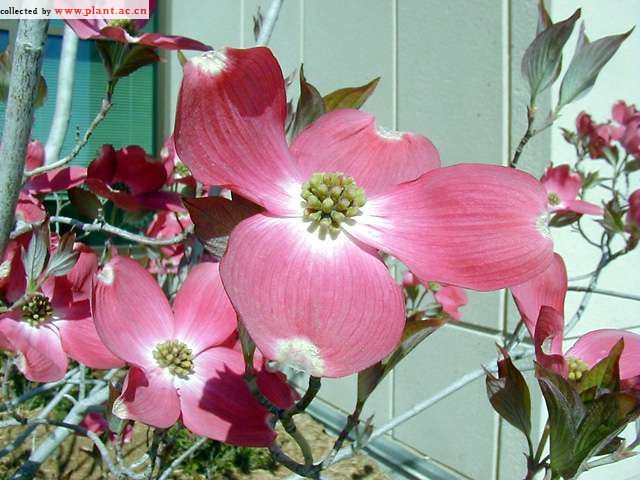Cornus florida Cherokee ChiefFlowering dogwood
科:山茱萸科
Family:Cornaceae
属:山茱萸属
common name:Flowering dogwood
introduce:Plant Type: Tree
Family: Cornaceae
Missouri Native: No
Native Range: None
Height: 15 to 30 feet
Spread: 15 to 30 feet
Bloom Time: April - May
Bloom Color: Rose red
Sun: Full sun to part shade
Water: Medium moisture
Maintenance: Medium
General Culture:
Easily grown in average, medium moisture, well-drained soils in full sun to part shade. Prefers moist, organically rich, acidic soils in part shade. Benefits from a 2-4?mulch which will help keep roots cool and moist in summer. May be inadvisable at this time to plant this tree in areas where dogwood anthracnose infestations are present (see problems section below).
Noteworthy Characteristics:
Flowering dogwood (Cornus florida) is the Missouri State Tree, and arguably may be the most beautiful of the native American flowering trees. It is a small deciduous tree that typically grows 15-30?tall with a low-branching, broadly-pyramidal but somewhat flat-topped habit. Blooms in early spring shortly after, but usually overlapping, the bloom period of the redbuds. The true dogwood flowers are actually tiny, yellowish green and insignificant, being compacted into button-like clusters. However, each flower cluster is surrounded by four showy, white, petal-like bracts which open flat, giving the appearance of a single, large, 3-4?diameter, 4-petaled, white flower. Oval, dark green leaves (3-6?long) turn attractive shades of red in fall. Bright red fruits (poisonous to humans but loved by birds) mature in late summer to early fall and may persist until late in the year. 慍herokee Chief?is a cultivar that is noted for it deep rose red floral bracts. New foliage is tinged with red. U. S. Plant Patent PP1710 (1958).
Problems:
Flowering dogwood, when stressed, is susceptible to a rather large number of disease problems the most serious of which is dogwood anthracnose. Although this anthracnose is not yet a serious problem in Missouri, it has caused considerable devastation in parts of the eastern U.S. Also susceptible to leaf spot, crown canker, root rot and leaf and twig blight. Stressed trees also become vulnerable to borers. Leaf miner and scale are less serious potential insect pests.
Uses:
Popular as a specimen or small grouping on residential property around homes, near patios or in lawns. Also effective in woodland, bird or native plant gardens.
